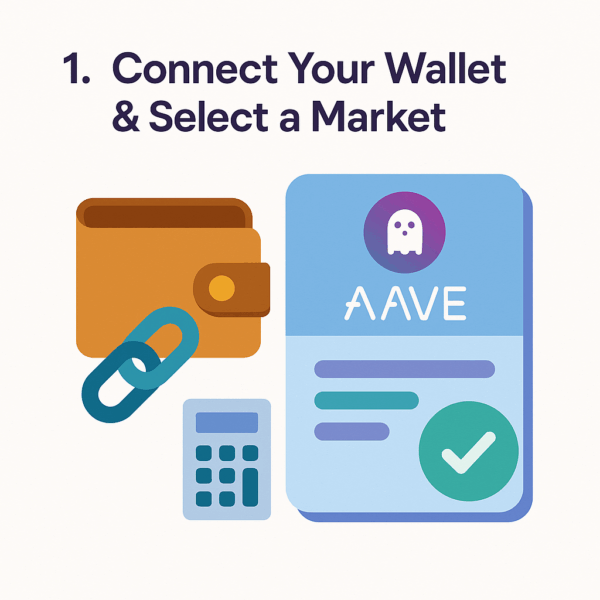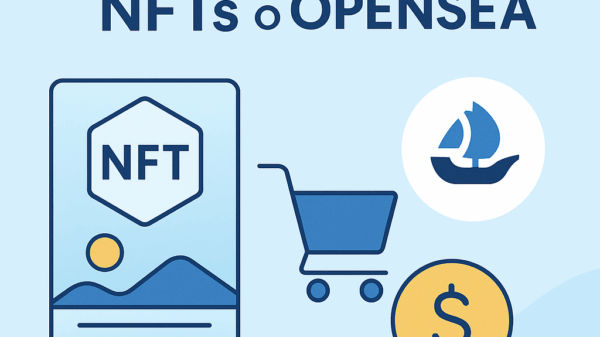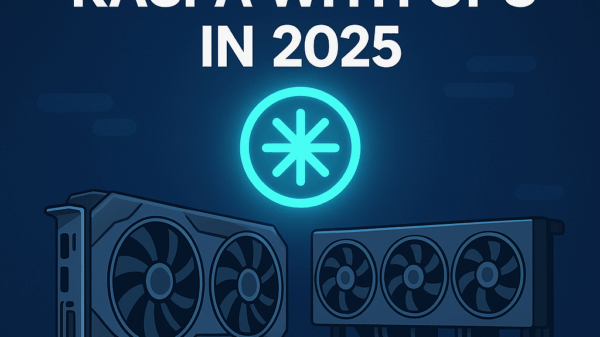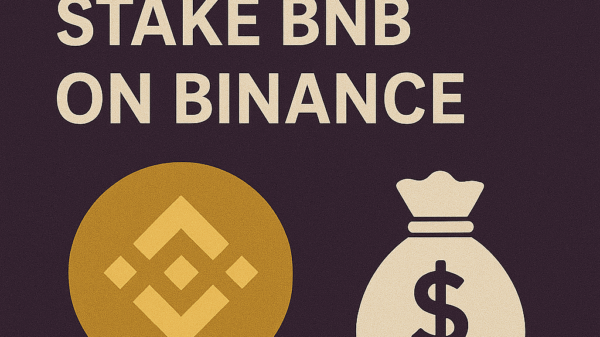How to Use Aave for Lending
By Jason Miller – Crypto Writer 10.expert 🧠 Covering Bitcoin, altcoins, blockchain & Web3.
As a crypto writer and analyst, few protocols exemplify the power of decentralized finance (DeFi) quite like Aave. It’s a non-custodial liquidity protocol that allows users to seamlessly lend and borrow cryptocurrencies, all without the need for traditional banks or intermediaries. Instead, smart contracts facilitate the entire process, making it transparent, efficient, and accessible to anyone with an internet connection.
Aave operates on a pooled liquidity model. Lenders (or “depositors”) provide crypto assets to liquidity pools, and in return, they earn interest. Borrowers can then draw from these pools, typically by providing overcollateralization with other crypto assets. The interest rates are dynamic, adjusting algorithmically based on the supply and demand (utilization rate) within each pool, ensuring a balance between available liquidity and borrowing demand.
In 2025, Aave continues to be a cornerstone of the DeFi ecosystem, having expanded across multiple blockchain networks like Ethereum, Polygon, Arbitrum, Avalanche, and more. Lending on Aave is a popular way to earn passive income on your crypto holdings, but it’s essential to understand the mechanics and associated risks.
Let’s explore how to use Aave for lending.
How to Use Aave for Lending: Earn Passive Income on Your Crypto Assets 💰📈
Lending on Aave is a straightforward process, but understanding the underlying mechanisms and risks is key to a successful experience.
Understand Aave’s Core Concept: Liquidity Pools & Interest Rates 💡
- Liquidity Pools: As a lender, you deposit your crypto into a pool for a specific asset (e.g., a pool for USDC, a pool for ETH). This pool then supplies funds to borrowers.
- Dynamic Interest Rates: The interest rate you earn (and borrowers pay) is not fixed. It fluctuates based on the utilization rate of the pool – how much of the deposited assets are currently being borrowed. Higher utilization generally means higher interest rates for lenders, as the protocol incentivizes more deposits.
- aTokens: When you deposit assets into Aave, you receive “aTokens” (e.g., aUSDC for USDC, aETH for ETH). These are interest-bearing tokens that represent your claim on the underlying deposited assets plus the accrued interest. They grow in value over time.
Choose a Compatible Web3 Wallet 🦊
- You’ll need a non-custodial wallet that supports the blockchain network you intend to use Aave on.
- MetaMask: The most popular browser extension wallet, compatible with Ethereum and many EVM-compatible networks (Polygon, Arbitrum, etc.).
- WalletConnect: Allows you to connect various mobile wallets (e.g., Trust Wallet, Rainbow Wallet) by scanning a QR code.
- Hardware Wallets: For maximum security, connect your hardware wallet (Ledger, Trezor) through MetaMask or WalletConnect.
Ensure You Have Native Gas Tokens ⛽
- You’ll need the native token of the blockchain network (e.g., ETH for Ethereum, MATIC for Polygon, AVAX for Avalanche, BNB for BNB Smart Chain) to pay for transaction (gas) fees. These fees apply when you approve tokens, deposit, withdraw, or claim rewards.
- Official URL: Always go to
app.aave.com. Bookmark this URL to avoid phishing scams. - Security Check: Verify the URL is correct and look for the padlock icon in your browser.
Connect Your Wallet & Select a Market 🔗

- “Connect Wallet” Button: Click the “Connect Wallet” button (usually top right).
- Select Network/Market: Aave operates on multiple networks. Choose the network (e.g., “Ethereum V3,” “Polygon V3,” “Arbitrum V3”) that corresponds to where your funds are or where you want to deposit. This is crucial as funds cannot directly cross networks without bridging.
Browse Available Assets & APYs 📊
- “Markets” Page: Once connected, you’ll see a list of supported assets for that market (network).
- Supply APY: Aave displays the current Supply APY (Annual Percentage Yield) for each asset. This is the interest rate you can expect to earn. Keep in mind these are dynamic and can change frequently.
- Utilization Rate: Pay attention to the “Utilization Rate.” A very high utilization rate might mean slightly higher interest, but also a potentially lower amount of available liquidity for withdrawals.
Select the Asset You Wish to Supply (Lend) 🪙
- Click on the cryptocurrency you want to deposit (e.g., USDC, DAI, ETH, wBTC).
Approve Token Spending (First Time Only) ✅
- ERC-20 Approvals: If this is your first time depositing a specific ERC-20 token (like USDC or DAI), you’ll need to “Approve” Aave’s smart contract to spend that token from your wallet. This is a separate blockchain transaction and incurs a small gas fee.
- Confirm in Wallet: Your wallet will pop up asking for confirmation.
Enter the Amount to Deposit and Confirm 📥
- Input Amount: Enter the amount of the asset you wish to deposit.
- Review Details: Aave will show the current supply APY and any other relevant details.
- “Supply” Button: Click the “Supply” button.
- Confirm in Wallet: Your wallet will prompt you to confirm the main deposit transaction, which incurs another gas fee.
- Receive aTokens: Once the transaction is confirmed on the blockchain, you will receive the corresponding aTokens in your wallet.
Monitor Your Lending Position 👀
- “Dashboard” Tab: Aave’s “Dashboard” (or “My Dashboard”) provides an overview of your supplied assets, accrued interest, and net APY.
- Interest Accrual: Interest is earned continuously, in real-time, directly into your aToken balance. You don’t need to “claim” it daily; your aToken balance simply increases.
Understand Risks of Lending on Aave ⚠️
- Smart Contract Risk: Despite rigorous audits, there’s always a theoretical risk of a bug or exploit in Aave’s smart contracts.
- Liquidation Risk (for borrowers, but affects lenders): While primarily a borrower’s concern, if borrowers’ collateral falls below the liquidation threshold, their positions are liquidated. This mechanism ensures the protocol remains solvent and liquidity providers can always withdraw their funds, but it’s part of the system’s risk profile.
- Interest Rate Volatility: Supply APYs are dynamic. They can drop significantly if demand for borrowing decreases or supply increases.
- Token Price Risk: The value of the crypto assets you’re lending can decrease, even if you’re earning interest on them. Lending stablecoins (USDC, DAI, USDT) mitigates this price risk but introduces stablecoin de-peg risk.
- Oracle Risk: Aave relies on decentralized oracle networks (like Chainlink) for price feeds. If an oracle is compromised or provides incorrect data, it could impact liquidations or interest rates.
Withdraw Your Funds 📤
- “Dashboard” / “Withdraw”: On your Aave dashboard, select the asset you wish to withdraw.
- Enter Amount: Input the amount you want to withdraw.
- Confirm: Confirm the transaction in Aave and then in your wallet. Your aTokens will be burned, and the original asset (plus earned interest) will be returned to your wallet.
Explore Advanced Features (Optional) 🚀
- Delegated Voting: If you hold AAVE tokens, you can stake them or delegate your voting power to participate in Aave governance.
- Flash Loans: An advanced feature for developers allowing uncollateralized loans that must be repaid within the same blockchain transaction.
- Collateral Usage: You can use your supplied assets as collateral to borrow other assets (a separate, more complex operation with liquidation risks).
Tax Implications 🧾
- Interest as Income: Interest earned from lending on Aave is generally considered taxable income at its fair market value at the time it accrues (when your aToken balance increases).
- Record Keeping: Maintain meticulous records of all deposits, withdrawals, and interest accruals for tax reporting purposes. Crypto tax software can be very helpful here.
Stay Informed and Practice Security 🛡️
- Official Channels: Follow Aave’s official social media (Twitter/X, Discord) and documentation for updates.
- Security Best Practices: Always use strong, unique passwords and 2FA for your wallet. Never share your seed phrase. Be vigilant against phishing. Regularly review and revoke token approvals for dApps you no longer use.
Lending on Aave offers a powerful avenue for generating passive income in the DeFi space. By understanding the simple steps, the dynamic interest rate model, and crucially, the inherent risks, you can confidently participate in this decentralized money market.








